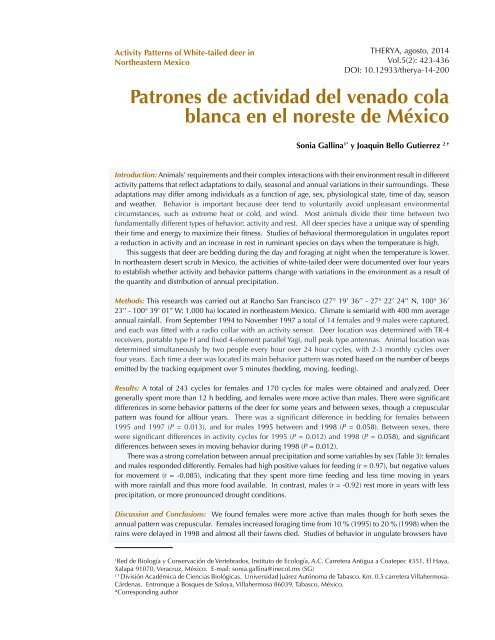therya-5_2
therya-5_2
therya-5_2
Create successful ePaper yourself
Turn your PDF publications into a flip-book with our unique Google optimized e-Paper software.
Activity Patterns of White-tailed deer in<br />
Northeastern Mexico<br />
THERYA, agosto, 2014<br />
Vol.5(2): 423-436<br />
DOI: 10.12933/<strong>therya</strong>-14-200<br />
Patrones de actividad del venado cola<br />
blanca en el noreste de México<br />
Sonia Gallina 1* y Joaquin Bello Gutierrez 2 †<br />
Introduction: Animals’ requirements and their complex interactions with their environment result in different<br />
activity patterns that reflect adaptations to daily, seasonal and annual variations in their surroundings. These<br />
adaptations may differ among individuals as a function of age, sex, physiological state, time of day, season<br />
and weather. Behavior is important because deer tend to voluntarily avoid unpleasant environmental<br />
circumstances, such as extreme heat or cold, and wind. Most animals divide their time between two<br />
fundamentally different types of behavior: activity and rest. All deer species have a unique way of spending<br />
their time and energy to maximize their fitness. Studies of behavioral thermoregulation in ungulates report<br />
a reduction in activity and an increase in rest in ruminant species on days when the temperature is high.<br />
This suggests that deer are bedding during the day and foraging at night when the temperature is lower.<br />
In northeastern desert scrub in Mexico, the activities of white-tailed deer were documented over four years<br />
to establish whether activity and behavior patterns change with variations in the environment as a result of<br />
the quantity and distribution of annual precipitation.<br />
Methods: This research was carried out at Rancho San Francisco (27° 19’ 36’’ - 27° 22’ 24’’ N, 100° 36’<br />
23’’ - 100° 39’ 01” W: 1,000 ha) located in northeastern Mexico. Climate is semiarid with 400 mm average<br />
annual rainfall. From September 1994 to November 1997 a total of 14 females and 9 males were captured,<br />
and each was fitted with a radio collar with an activity sensor. Deer location was determined with TR-4<br />
receivers, portable type H and fixed 4-element parallel Yagi, null peak type antennas. Animal location was<br />
determined simultaneously by two people every hour over 24 hour cycles, with 2-3 monthly cycles over<br />
four years. Each time a deer was located its main behavior pattern was noted based on the number of beeps<br />
emitted by the tracking equipment over 5 minutes (bedding, moving, feeding).<br />
Results: A total of 243 cycles for females and 170 cycles for males were obtained and analyzed. Deer<br />
generally spent more than 12 h bedding, and females were more active than males. There were significant<br />
differences in some behavior patterns of the deer for some years and between sexes, though a crepuscular<br />
pattern was found for allfour years. There was a significant difference in bedding for females between<br />
1995 and 1997 (P = 0.013), and for males 1995 between and 1998 (P = 0.058). Between sexes, there<br />
were significant differences in activity cycles for 1995 (P = 0.012) and 1998 (P = 0.058), and significant<br />
differences between sexes in moving behavior during 1998 (P = 0.012).<br />
There was a strong correlation between annual precipitation and some variables by sex (Table 3): females<br />
and males responded differently. Females had high positive values for feeding (r = 0.97), but negative values<br />
for movement (r = -0.085), indicating that they spent more time feeding and less time moving in years<br />
with more rainfall and thus more food available. In contrast, males (r = -0.92) rest more in years with less<br />
precipitation, or more pronounced drought conditions.<br />
Discussion and Conclusions: We found females were more active than males though for both sexes the<br />
annual pattern was crepuscular. Females increased foraging time from 10 % (1995) to 20 % (1998) when the<br />
rains were delayed in 1998 and almost all their fawns died. Studies of behavior in ungulate browsers have<br />
1<br />
Red de Biología y Conservación de Vertebrados, Instituto de Ecología, A.C. Carretera Antigua a Coatepec #351, El Haya,<br />
Xalapa 91070, Veracruz, México. E-mail: sonia.gallina@inecol.mx (SG)<br />
2 †<br />
División Académica de Ciencias Biológicas. Universidad Juárez Autónoma de Tabasco. Km. 0.5 carretera Villahermosa-<br />
Cárdenas. Entronque a Bosques de Saloya, Villahermosa 86039, Tabasco, México.<br />
*Corresponding author



